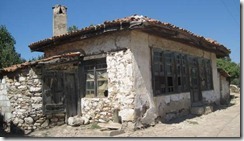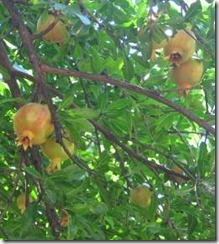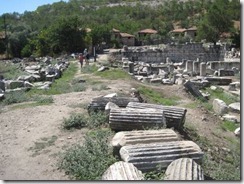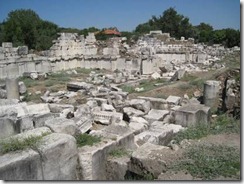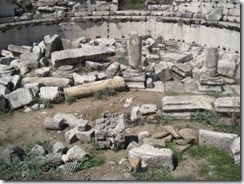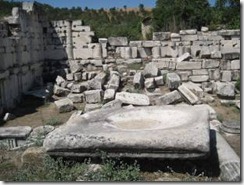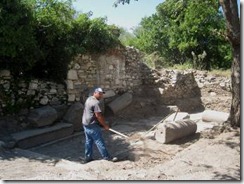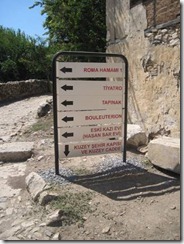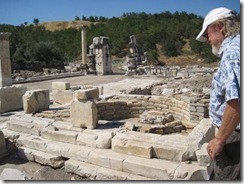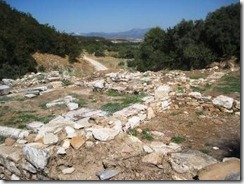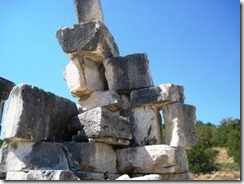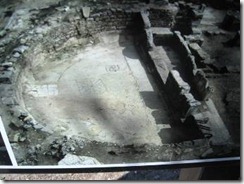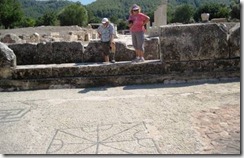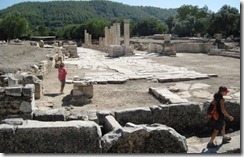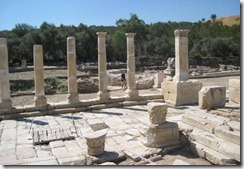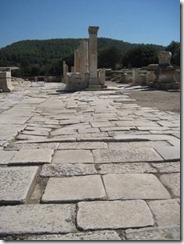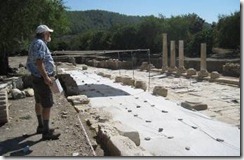Merhaba,
It seems as if every time we turn around this past week we bump into cruising friends from other parts of the world. Last night was the first Cruisers Happy Hour at Pineapple Restaurant. About 30 people showed; some new faces but many were familiar. Many of the familiar faces are moving on to other marinas along the coast of Turkey, but the new faces looked interesting too. Met one couple from California, Mary and Rick who like to hike and SHE PAINTS WATERCOLOR! How perfect for me!! They are on E dock and will be here all winter.
Bill and Judy (BeBe) will be moving as will Betty and David (Sundance) but it has been great spending time with them. I’m sure we’ll see them along the way.
Ru
ps Red Sox have thrown in the 2012 towel so it’s a really early "wait until next year" for me.
I meant to have included this photo last email as it does show the white wash over the stones of the Ottoman houses of Stratonikeia, the roof tiles and the chimney.
I’m still a pomegranate fan,and I was really hungry and thirsty, but these weren’t ripe or I would have picked one and hoped there weren’t any consequences….like a long winter. There were fig trees too.
Then on to Ancient Stratonikeia….
“The borders of Stratonikeia are known thanks to the fortification walls and its size can be easily determined. However, within the city only certain structures have been excavated. Therefore, our knowledge of the number of the structures on the city plan is limited. Based on the excavated structures and the street system, it is likely that the city was built on a grid plan. The structures in the city are fortification walls, city gate with its monumental fountain, the colonnaded street, gymnasium, bouleuterion (ancient Greek council chamber), bath, theater, temple and water structure.”
Stratonikeia brochure
We left the small Ottoman Square area and followed a path on our way to finding the mosaics Randal wanted to see. We found ourselves in ancient Greece at the Gymnasium.
Ozymandias
I met a traveller from an antique land
Who said: "Two vast and trunkless legs of stone
Stand in the desert. Near them on the sand,
Half sunk, a shattered visage lies, whose frown
And wrinkled lip and sneer of cold command
Tell that its sculptor well those passions read
Which yet survive, stamped on these lifeless things,
The hand that mocked them and the heart that fed.
And on the pedestal these words appear:
`My name is Ozymandias, King of Kings:
Look on my works, ye mighty, and despair!’
Nothing beside remains. Round the decay
Of that colossal wreck, boundless and bare,
The lone and level sands stretch far away
Percy Bysshe Shelley
We had to read that poem in high school where it meant little but now I can easily understand and appreciate.
The stones do tell their stories…. if you use your imagination and carbon dating.
Rubble: “A loose mass of angular fragments of rock or masonry crumbled by natural or human forces.” Perfect definition of these images.
Kolay Gelsin…. May it come easy. When you see someone working hard, that’s what you say in Turkish : Kolay Gelsin.
We followed the arrow Kuzey Cadde to find the mosaics…only getting a little lost but finding our way.
Judy made the correct guess, just in time before we were about to give up.
Northern City Gate and Fountain
"The northern city gate located on the northern fortification wall is where the sacred road coming from the Lagina Hekate sacred precinct after passing the necropolis, meets the city. Therefore, the Northern City Gate is of great importance both as an entrance and as a ritualistic place.
The northern city gate is quite large and has a monumental arched entrance on either side. The exterior façade of the gate is in Doric order. The façade facing the city with its monumental fountain of semi-circular pools between the two entrances is decorated with two-tiered columns and statues and is in Corinthian order. Based on the remains and the architectural features, the gate must have measured 42.5 m wide and 14.20 m high.
Based on the architectural and sculptural works, the gate must have been built after the Late Antonine-Early Severan period following the earthquake of A.D. 140." http://pau.edu.tr/stratonikeia/en/sayfa4858.aspx
Looking away from the gates back towards Mugla
The arch from the gateway
The fountain
Randal and Judy looking at the mosaics: my favorites are still the flip flops and pomegranates in Sipahi.
Colonnaded Street (that’s me in the right corner proving I was really there too.)
“The Colonnaded Street, 8.70 meters wide, begins from the south mid section of the open area in front of the northern city gate and continues towards the city center. …..In front of the gate is a 42 meter wide open space surrounded by 8 monumental Corinthian columns and shops on the west. This is where people who entered the city and those who came from the city to use the fountain gathered.
In the arrangements of the city gate and the street that were completed in the mid-2nd century A.D. and later, care has been taken to preserve the monument as it is.
The area around the gate and the street collapsed during an earthquake and in the byzantine period using architectural elements from the city, new buildings and the colonnaded street were built.”
Stratonikeia brochure
Bill walking among the columns
How ancient is this!!!
Randal was disappointed that the mosaics were covered, but he was able to see a bit through the plastic.
Two interesting links if you want more info about Stratonikeia
"A good copy of Diocletian’s well-known Edict on Prices and Wages exists at Stratonikeia. This impressive site barely rates a mention in the guide books, which means it is little visited and so easy to walk round. The Turkish village of Eskihisar occupies part of the site, but after an earthquake in 1957, most of the inhabitants moved out and there is now just a small café and gift shop and some interesting old houses." http://www.forumancientcoins.com/historia/turkey/stratonikeia.htm
Stratonikeia – nearly buried again http://www.bodrumpages.com/turkey/ancient_sites/stratonikeia_E.html

